Origins of Tables & Tablets
I have run a lot of D&D, mostly 5e. I always struggled to tailor combat for my experienced group; I wanted dangerous encounters but never force players into them. It never landed as I hoped. Born from this is a system where the gloves aren't just off, they were never crafted in the first place.

Of the pillars of play, combat has always been my weakest. I never liked the idea of luring my players into a death trap, but have found that dangerous situations in games like 5e can be recovered from thanks to the likes of expendable resources -- which are usually reserved for these moments -- & the safety net of "death saving throws". I wanted a ruleset which made combat raw & deadly. Deadliness should work on both sides however, meaning combat should quickly resolve in favour of the stronger side. Engineering this advantage is what I want my player's minds focused on.
I originally played around with having multiple health pools & I already decided that I didn't want to have "multiattacks". Result Tables came from wanting weapons to be able to affect more than one health pool in a single attack & for this I needed descriptive roll results -- which survived me dropping the varied health pools. Results like "X damage + Dismemberment" naturally came about once I had Result Table rows to populate, instead of only having a die size to choose for each weapon.
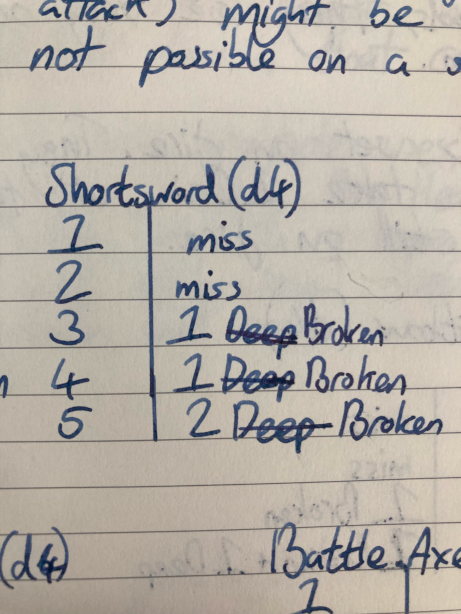
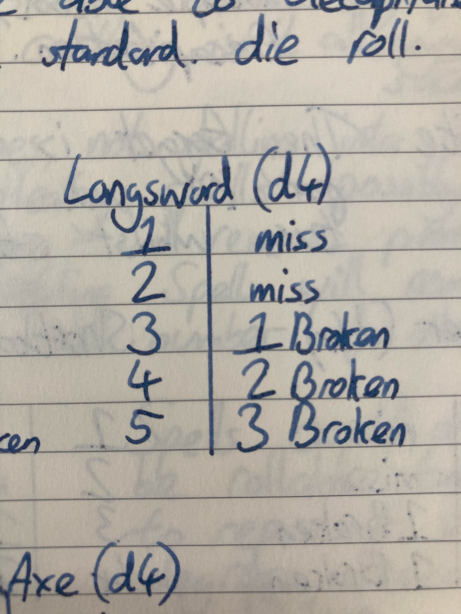
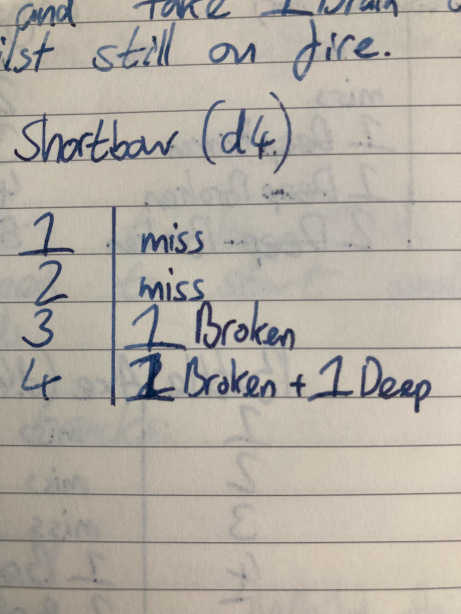
Tablets are the natural combination of spells & Result Tables, avoiding the justification for why a spell book takes up a whole inventory slot.
What emerged during development
Inventory Slots
I had already started developing what is now Tables & Tablets when I discovered Ben Milton's Knave. I immediately loved the inventory system, how every item a PC held had to be meaningful, as it took at up one of their precious inventory slots, & how health tied to these slots; I had my multiple health pools back, but in a better form: quick recovering HP for stamina & slow recovering inventory slots for mortality
Close to when Tables & Tablets was complete, I made the snap decision to reduce the number of inventory slots a PC starts with from 10 down to 6. Given the type of game I wanted to create, I never looked back. I think this changed the game from one about heroes to a ruleset about everyday people whose lives were at constant risk. Players would always need to consider their next move & given their limited inventory, weigh up the options of what they would carry.
Similar to this inventory slot change, I didn't want the starting PC who rolled the most HP to be elected the "tank", obliged to walk first into new rooms & ironically become the most likely to die. What emerged was that all Level 1 PCs start with 4 HP, all PCs gain +1 HP per level & any additional HP comes from their chosen Improvements. A Level 1 PC might still roll additional HP, so this scenario still exists but is much less likely. I didn't feel strong enough about this to make rolling extra HP during PC creation impossible. The option to begin with Level 0 PCs is what a group has to ensure that no player is crowned the party punching bag.
With base HP mostly static, a player chooses to become a "tank" & has multiple options for this: do they increase their fast-recovering HP, increase their inventory slots to be able to wear more armour & take more wounds, or do they improve both of these at the cost of not increasing any other stats? The choice is in their hands.
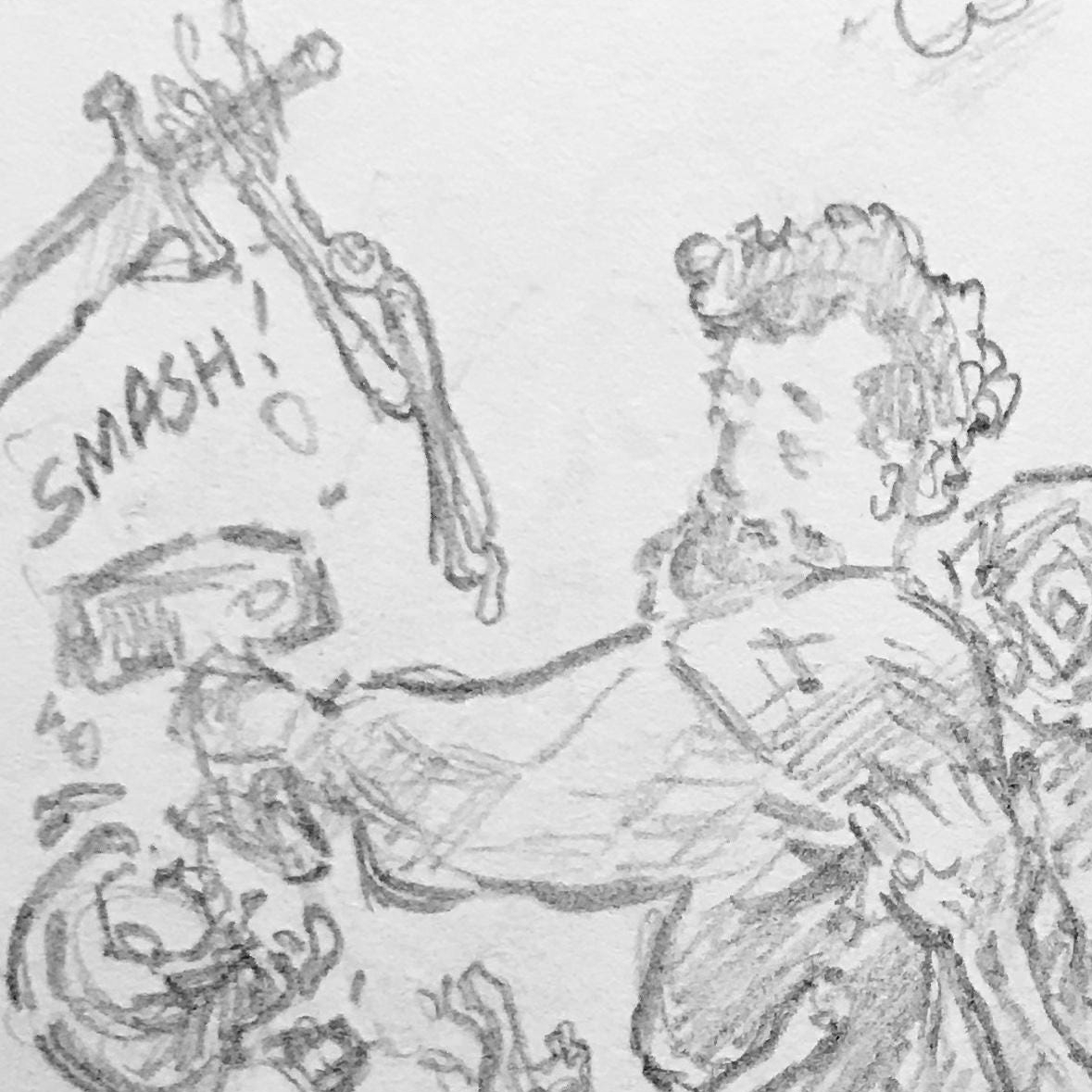
Tablets & their Personalities
Originally Tablets started with different numbers of rows & even the die rolled for them. I eventually settled on a d4 for all, with a result of 0 which only occurs when there's a penalty to the roll & a result of 5 which is only attainable with a bonus -- usually by having 1 INT or higher. These two exceptional results allowed me to create devastating outcomes that wouldn't instantly kill a PC on a bad first roll or wipe out a whole encounter on a great roll -- without at least having a point of INT.
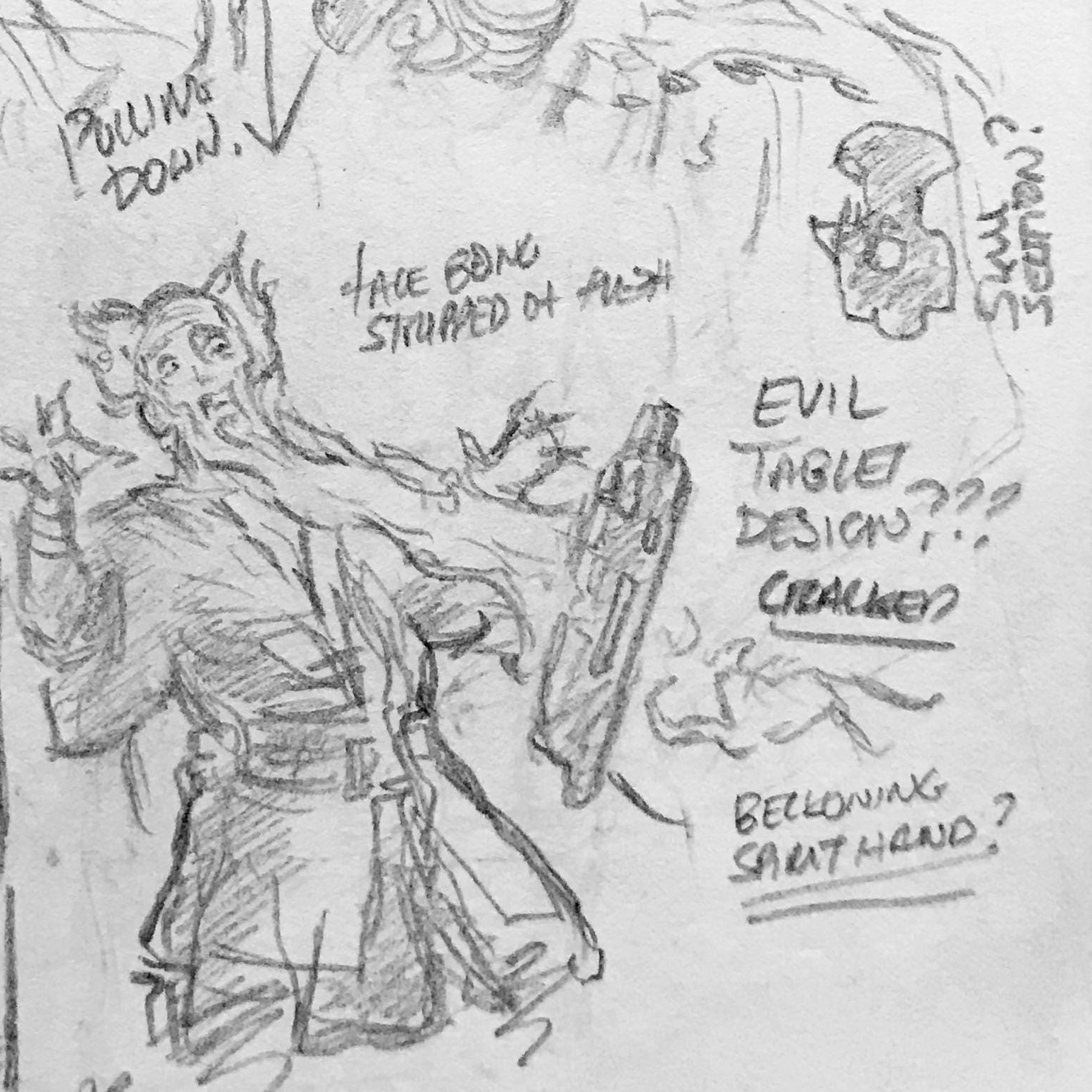
For a while I had an option to "restrict" the casting of a Tablet's spell by imposing a player-decided penalty to the roll. I had this because the higher, more powerful results had drawbacks, such as the highest result of Conjure Sea Water having the most likely chance of summoning an elemental, & I wanted players to have the option of avoiding these if they wanted. This was eventually replaced with the highest results always being desirable. There was now no scenario where a PC would want to avoid the best results, except for player-driven role-playing, for which I'll leave the adjudication down to individual Referees. One suggestion I would have for Referees on this is a note that the bound magic within a Tablet is intended to be what casts the spell, & not the PC. How would the PC "hold back"? Perhaps by not using the full potential of their INT in the battle of wills & minds?
The last element I added to Tablets were their personalities. This was originally inspired by Harry's (the cover artist's) image of the head emerging from the Tablet in the artwork; it got me thinking about what each bound magic looked like. For each Tablet, once I new the spell effect (which formed results 3, 4 & 5) I needed to think of the negative results (0 & 1), the dungeon modifying result (2), how the Tablet would be appeased & how the bound magic of the Tablet would communicate with PCs. Coming up with these for all of the Tablets was easily the single most time-consuming aspect of the system.
After wading through the ideas I was having for these, I found that if I instead settled on the bound magic's personality first, the missing details of a Tablet's properties fell into place quite quickly afterwards. What was previously a search in the dark for these aspects of each Tablet became what felt like turning pages in the bound magic's life story.
The bound magic of Fear is afraid, & wants the PCs to share these feelings. That's why appeasing this Tablet requires PCs to voluntarily face fears & feel every second of it. The Tablet will shift the actions of this PC towards danger, pulling at their personality, just like how the greedy bound magic of Burning Hands incentivizes a PC seeking more & more treasure. I like the idea of a PC invested in using Tablets partly role-playing the will of the bound magic they hold. Is there a point when it's the bound magic of the Tablets that are leading the party?
I feel that there's much more that can be done with Tablets, & Result Tablets in general. I toyed with the idea of two Tablets who are appeased by rolling high on the other -- the bound magic of these two Tablets hating each other & therefore enjoying seeing the PC impose their will on them; the spells of these competing Tablets would be equally adversarial & would see the caster shifting between two states. Board & Nail is the only example of a weapon that can break on a low result. I thought of having a weapon like this be the first the prisoner PCs come across in Abandoned in Bulk, but decided against this given they require more thought & tracking compared with the standard d4 weapons like the Shortsword or Axe.
I would love to see new Result Tables designed by others. If anyone is interested in seeing more from me, I can share what I have come up with in the future, including some that didn't make it into the original release.
Combat Phases
I wanted no individual player turns. Side-based initiative was the next best way of handling combat I was aware of. When I stumbled upon the idea online that a Referee could adjudicate simultaneous actions, I immediately preferred this over any form of initiative
Running through my memory of countless combat encounters, it stood out to me that some form of structure would still be needed: for example, could a PC move, attack & retreat all in one round? How would an enemy be able to attack them or what if they used the same strategy?
Given the potency & investment required of magic, I wanted Tablets to be resolved first; a well-placed spell might cut combat short for a start. Ranged seemed like the next best phase to have & I liked the idea of a creature shooting down an enemy before they could reach them; the trade-off is the scenario where a melee-based creature manages to close the distance. During playtesting, ranged weapons proved to be very powerful, but I stuck by the existing design, confident in the idea that leaning into using actions in the phase has its risks as well as rewards. I also took comfort in the idea that any strategy that the PCs employ is something that a group of monsters might turn back on them.
The Additional Movement phase came out of a need to handle a chase, or a creature fleeing from another & I didn't want to introduce something like "opportunity attacks" from 5e. Splitting movement to be either side of the Melee phase resolved this & allowed for something like the "dash" action.
I originally allowed held actions, such as a PC holding off firing an arrow from their bow until a monster had moved during the Movement phase. Once one player started using this, more & more did & soon it became hard to track. Removing this simplified combat again & reintroduced more tactical play. It also gives a slight boost to melee attacks, given in the first round of combat a creature can move in & then attack, not relying on situational factors such as needing to be able to see a target already.
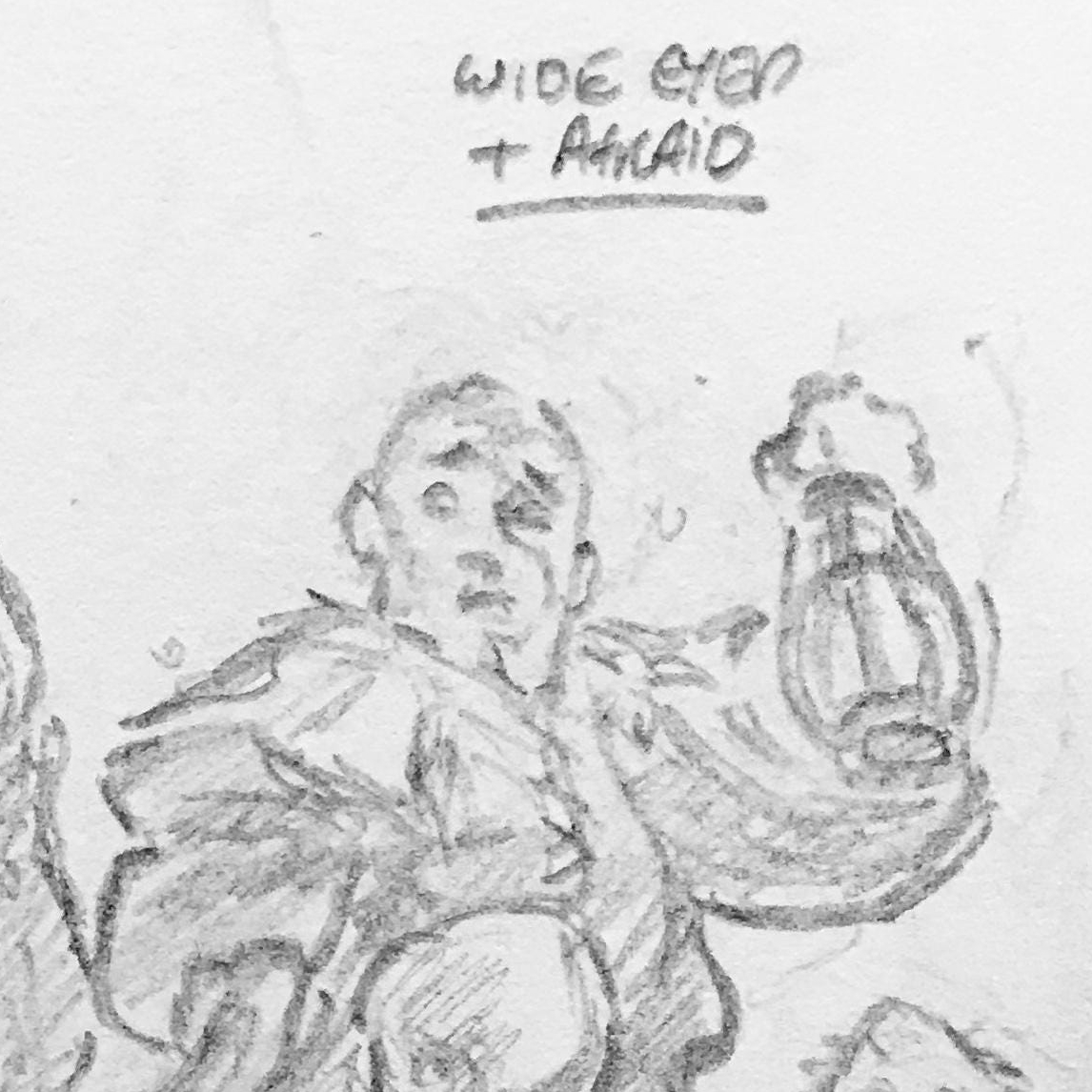
Intro Dungeon
I was advised to write a dungeon that could be immediately played using the ruleset. I didn't originally see its necessity, thinking that monsters from existing adventures could be quickly adapted to the system by assigning their attack to one of the options on the Monster Result Table, choosing their level (& deriving HP from this*) & their defences.
*setting a monster's HP based on their level isn't something I've explicitly outlined, but anyone who reads through the existing monster list might be able to see how I determined these.
I soon listened to this advice & I'm very glad I did. What I found most useful of all was the feedback loop the ruleset & the adventure began to have: a change in one would see me refining the other. Since I wanted to the dungeon to introduce the rules of Tables & Tablets bit by bit, I found myself looking at the rules from a fresh perspective, thinking about how to present these & how players would likely interact with them. When I introduced obstacles like the Hole in the Hallway & the Fissure, I went back to the rules to introduce the "success at a cost", given that I wanted to keep the pace of the adventure moving. A few more Tablets were born from the intro dungeon, mostly notably Miniaturise which was my most obvious way of showcasing how a creature's size could affect the dungeon delve & provide new opportunities. Conceal wouldn't have been created had I not been thinking as much about Delve Presence -- which for a long time was called the Delve Counter & counted down instead of up -- as a I had for this specific dungeon.
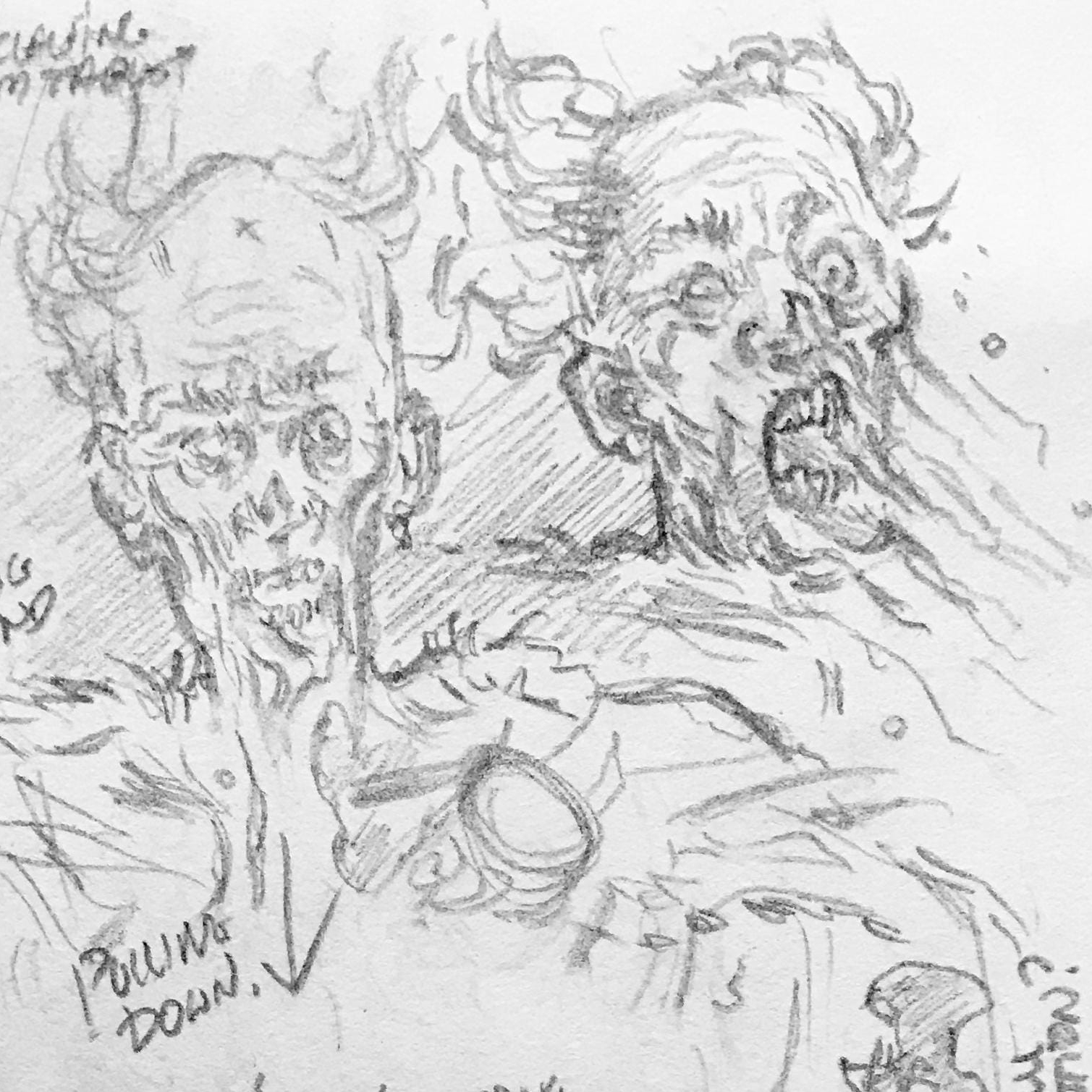
The Outcome
During playtesting of Abandoned in Bulk one of my players, who I've played D&D with for 7 years weekly, said to me: "That's the first time you've killed one of my characters". This was a clear sign that the system, that is Tables & Tablets today, was doing what I wanted: presenting deadly combat where it was the player's choice to put themselves at risk, where the odds where knowable & as soon as all of their slots were wounded it was game over. When this player discovered that the fight they died in could have gone very different if the party fled or followed a different strategy & had different weapons -- therefore have different Result Tables to roll on -- the death felt fair & they'd learned something.
Get Tables & Tablets
Tables & Tablets
A role-playing ruleset for dungeon delving.
| Status | Released |
| Category | Physical game |
| Author | Thomas Heslin |
| Tags | Dungeon Crawler, Dungeons & Dragons, OSR, pen-and-paper, rules-lite, Tabletop, tabletop-role-playing-game, Tabletop role-playing game |
| Languages | English |
More posts
- No Ballet in Barovia; or, making system match "feel"Jul 22, 2025
- Free 75 page preview now available!Jul 04, 2025
- Blessing to Live: Designing a TabletJun 19, 2025
- Some Monsters of Tablets & TabletsMay 04, 2025
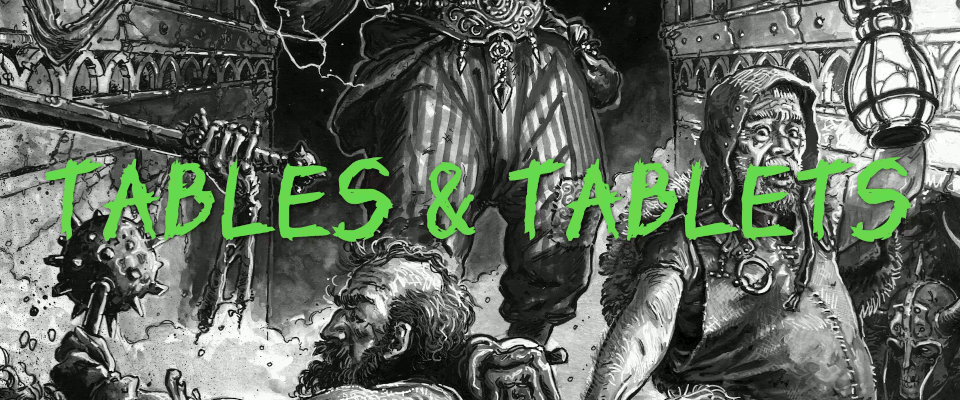
Leave a comment
Log in with itch.io to leave a comment.